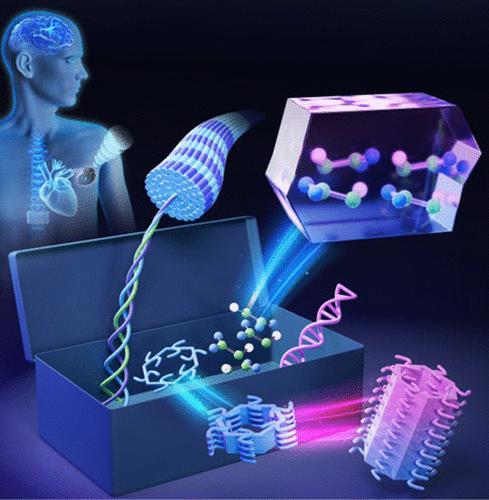用于生物电子学和生物医学应用的压电生物材料的设计与制造
IF 55.8
1区 化学
Q1 CHEMISTRY, MULTIDISCIPLINARY
引用次数: 0
摘要
压电效应能够实现电能和机械能之间的转换,使其在各个领域都必不可少。虽然合成压电陶瓷和聚合物广泛应用于电子和生物医学,但其固有的刚性,易碎性,加工挑战,毒性和不可降解性限制了它们的潜力。相比之下,压电生物材料由于其天然的生物相容性、生物可降解性和环境友好性,在生物医学领域提供了一个很有前途的选择。然而,弱压电性和大规模制造的挑战阻碍了它们的应用。本文回顾了压电生物材料的最新进展,主要集中在设计策略和制造方法上。我们首先总结了各种压电生物材料的原理、优点和分类。接下来,我们将探索计算研究,重点介绍分子工程和制造中的新兴方法,并研究它们在生物电子学和生物医学中的前沿应用。此外,我们评估了各种设计和制造方法在提高压电性能方面的有效性,概述了它们各自的优势和局限性。最后,我们讨论了关键挑战,并提供了对计算建模,制造技术,表征方法和生物医学应用的见解,以指导未来的研究。本文章由计算机程序翻译,如有差异,请以英文原文为准。

Design and Manufacturing of Piezoelectric Biomaterials for Bioelectronics and Biomedical Applications
The piezoelectric effect enables the conversion between electrical and mechanical energy, making it essential across various fields. While synthetic piezoelectric ceramics and polymers are extensively utilized in electronics and biomedicine, their inherent rigidity, fragility, processing challenges, toxicity, and nondegradability limit their potential. In contrast, piezoelectric biomaterials offer a promising alternative for biomedical fields because of their natural biocompatibility, biodegradability, and environmental friendliness. However, weak piezoelectricity and challenges in large-scale fabrication hinder their applications. This paper critically reviews recent advances in piezoelectric biomaterials, focusing primarily on design strategies and manufacturing methods. We first summarize the principles, advantages, and categories of a variety of piezoelectric biomaterials. Next, we explore computational studies, highlight emerging approaches in molecular engineering and manufacturing, and examine their cutting-edge applications in bioelectronics and biomedicine. Additionally, we evaluate the effectiveness of various design and manufacturing approaches in enhancing piezoelectric performance, outlining their respective advantages and limitations. Finally, we discuss key challenges and provide insights into computational modeling, fabrication techniques, characterization methods, and biomedical applications to guide future research.
求助全文
通过发布文献求助,成功后即可免费获取论文全文。
去求助
来源期刊

Chemical Reviews
化学-化学综合
CiteScore
106.00
自引率
1.10%
发文量
278
审稿时长
4.3 months
期刊介绍:
Chemical Reviews is a highly regarded and highest-ranked journal covering the general topic of chemistry. Its mission is to provide comprehensive, authoritative, critical, and readable reviews of important recent research in organic, inorganic, physical, analytical, theoretical, and biological chemistry.
Since 1985, Chemical Reviews has also published periodic thematic issues that focus on a single theme or direction of emerging research.
 求助内容:
求助内容: 应助结果提醒方式:
应助结果提醒方式:


